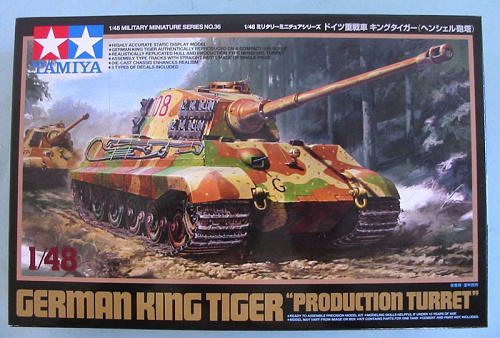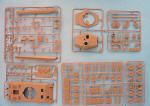
| KIT: | Tamiya 1/48 King Tiger |
| KIT #: | ? |
| PRICE: | 1800 yen at www.hlj.com |
| DECALS: | Three options |
| REVIEWER: | Tom Cleaver |
| NOTES: |

| HISTORY |
The Panzerkampfwagen VI Ausf. B, also designated Sonderkraftfahrzeug 182 (Sd. Kfz. 182), was given the popular name Tiger II or Königstiger, which is German for Bengal Tiger, and was often literally translated as King Tiger.
While it was officially a further development of the Tiger I heavy tank, the Tiger II was more a development of the Panther than the Tiger. Specifically, it utilized the sloped armor technology of the Panther, which was itself inspired by the Soviet T-34. While the Tiger II armor was 150mm thick, it was effectively thicker because of the sloped design of the hull, making it as close to impervious to enemy fire as any tank used during the Second World War.
The
main armament of the Tiger II was developed from the 88mm anti tank gun, and was
as far more powerful than that on the Tiger 1. Originally, the intention was to
mount an 88mm Flak 41 into a turret, but this proved impossible. In 1943, Krupp
was ordered to design a new turret that could mount their own 71 caliber 88mm
Kwk 43 cannon, which had a muzzle velocity of 1000m per second. It was highly
accurate and could penetrate 150mm of armor at more than 2,200 meters, which
made the Tiger II ideally suited to open terrain where it could engage enemy
tanks at long range before the opponent’s weapons were even in range.
The
major weakness of the Tiger II was its engine. The Maybach HL 230 P30 engine
was the same as was used by the far lighter Panther. Since the Tiger II was 11
tons heavier than the Panther, it was underpowered and could achieve only 35 to
38 km/h on the road and 17 km/h cross country. It was necessary to run the
engine at full power just to get the tank moving. Henschel & Son's chief
designer Erwin Adlers explained that "the breakdowns can be attributed to the
fact that the Tiger II had to go straight into series production without the
benefit of test results."
The initial design of the turret used by the Tiger II is sometimes misleading called the "Porsche turret" due to the belief that it was designed by Porsche for their prototype. In fact the “Porsche turret” is the initial Krupp design for both Porsche and Henschel prototypes. The turret had a rounded front with steeply-sloped sides and a difficult-to-manufacture curved bulge for the commander's cupola. 50 of these early turrets were mounted to Henschel's hull and used in combat. The more common “production” turret, which is also called the “Henschel” turret, was simplified with a flat face, no shot trap, less steeply-sloped sides, and no bulge for the commander's cupola.
The Tiger II first entered combat in Normandy on July 18, 1944 with the "Schwere Panzer Abteilung 503". It was first used on the Eastern Front on August 12, 1944, with "Schwere Panzer Abteilung 501," opposing the Red Army’s Baranov bridgehead over the Vistula River. It saw combat during Operation Market Garden that September, the Ardennes Offensive, the Soviet offensive into Poland and East Prussia in January 1945, the German offensives in Hungary in 1945, and in the fighting to the east of Berlin at the Seelowe Heights in April 1945.
The Tiger II was nearly impervious to Allied tanks on the Western Front, though the Sherman-equipped 4th/7th Royal Dragoon Guards claimed they knocked out a King Tiger on August 8, 1944, in France. The great firepower and armor of the Tiger II, which was able to destroy enemy tanks at extreme range while remaining impervious to those same tanks created a terrific reputation for the tank. For Allied tankers in Shermans and even the early Pattons, the mere sight of a Tiger II was terrifying and did great physical and morale damage.
Due to the size and weight of the Tiger II, many roads and bridges were unusable. Fuel requirements were enormous, and more Tiger IIs were abandoned for lack of fuel than for combat loss during the Ardennes Offensive. Production also suffered with the when the Henschel factory was bombed in early 1945. The Königstiger was a case of too late and too few to make any difference in the outcome of the war.
| THE KIT |
 I
think the only scale that Tamiya hasn’t made a Tiger II in (so far) is 1/72.
Their huge 1/16 radio-controlled Tiger II is one of the best of these big tank
models that’s ever been produced, and is always a popular prize for the lucky
modeler who wins one at TamiyaCon. I’ve admired models of their 1/35 Tiger II
for many years. This 1/48 Tiger II is pretty close to a perfect scale-down of
the bigger kits.
I
think the only scale that Tamiya hasn’t made a Tiger II in (so far) is 1/72.
Their huge 1/16 radio-controlled Tiger II is one of the best of these big tank
models that’s ever been produced, and is always a popular prize for the lucky
modeler who wins one at TamiyaCon. I’ve admired models of their 1/35 Tiger II
for many years. This 1/48 Tiger II is pretty close to a perfect scale-down of
the bigger kits.
As is now standard, there is a sprue for the hull with its associated gear, a sprue for the turret, and two identical sprues for the road wheels and tracks, all in tan plastic. These sprues are all crisply molded, and the small detail parts are all separate. The lower hull is diecast. The kit includes decals for three Tiger IIs, one from Schwere Panzer Abteilung 501 in Belgium during the Battle of the Bulge, one from Schwere Panzer Abteilung 502 on the Oder River Front in 1945, and one from Schwere Panzer Abteilung 505 in Poland in 1944. This last one is supposed to have Zimmerit on it.
| CONCLUSIONS |
An excellent kit of a famous tank that looks like it will build up into a good-looking model. I’ve definitely become a convert with these 1/48 tanks from Tamiya.
August 2006
Review kit courtesy HobbyLink Japan. Get yours at “Japanese Prices” at www.hlj.com
If you would like your product reviewed fairly and quickly by a site that has nearly 325,000 visitors a month, please contact me or see other details in the Note to Contributors.